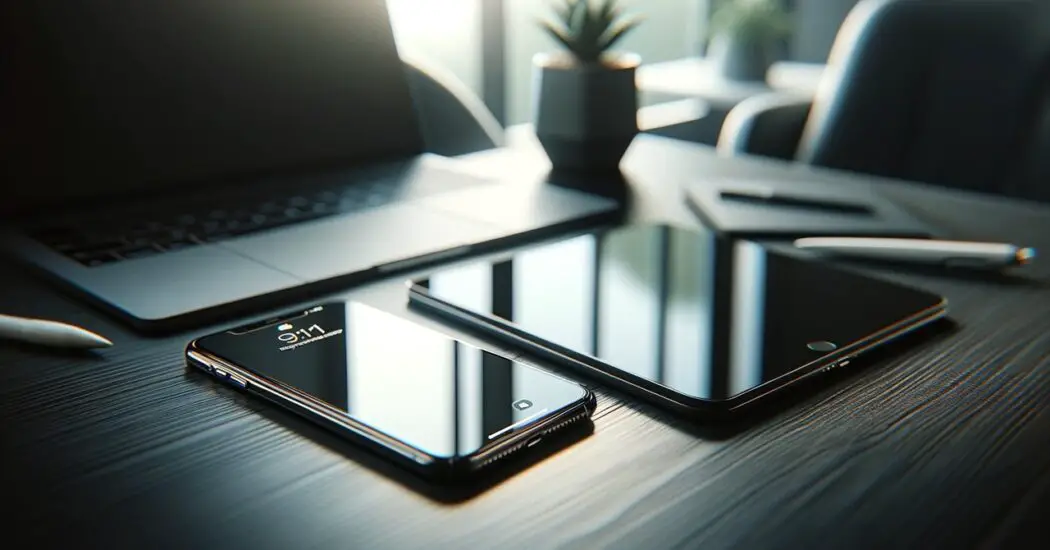With the increasing need for virtual communication, understanding how to use an iPhone camera as webcam for iPads can significantly enhance your video calling experience. This guide will walk you through the process, ensuring you can connect and use these devices seamlessly for improved video quality.

Table of Contents
How to Use an iPhone Camera as Webcam for iPad
Follow the steps below to use an iPhone camera as webcam for iPad
Step 1: Gather Necessary Equipment
Understanding the Basics: To start, it’s essential to have two key pieces of equipment: an iPhone and an iPad. The iPhone will serve as your webcam, while the iPad will be the display screen during your video calls.
Checking the iPhone Camera: Ensure your iPhone’s camera is functioning correctly. You can quickly test this by opening the Camera app and checking both the front and rear cameras. If there are any issues with the camera, these might need to be resolved before proceeding.
Preparing Your iPad: Your iPad will act as the receiving device, displaying the video feed from your iPhone. Make sure it is in good working order and that the screen is clear and undamaged for the best viewing experience.
Updating iOS: For the best compatibility and performance, both your iPhone and iPad should be updated to the latest iOS version. To check for updates, go to ‘Settings,’ then ‘General,’ and tap on ‘Software Update.’
If an update is available, follow the on-screen instructions to download and install it. Keeping both devices updated ensures better app compatibility and security, and often enhances overall performance.
Step 2: Install Required Apps
The next step is to install the necessary apps to use your iPhone camera as webcam for your iPad…
Choosing the Right App
To turn your iPhone into a webcam for your iPad, you need a specialized app. There are various options available on the App Store, such as ‘EpocCam‘ and ‘iVCam.’ These apps are specifically designed to link your iPhone’s camera to your iPad, effectively turning it into a high-quality webcam.
Downloading the App
Open the App Store on both your iPhone and iPad. Search for the webcam app of your choice, like ‘EpocCam’ or ‘iVCam.’ Read through the app descriptions and reviews to ensure you’re choosing the best option for your needs. Once decided, download and install the app on both devices.
Important Note on Compatibility: Ensure that the app you choose is compatible with both your iPhone and iPad models. Compatibility information is usually listed in the app description on the App Store.
Installation Process: After downloading the app, follow the installation instructions. This may include allowing necessary permissions, such as access to the camera and microphone on your iPhone.
Seamless Integration
It’s crucial to install the same webcam app on both your iPhone and iPad. This ensures that both devices can communicate effectively and minimizes any compatibility issues. By using the same app on both devices, you ensure a smoother, more stable connection, leading to better video quality during your calls or streams.
Read more iPhone camera topics here – iPhone Camera: How To, Problems & Solutions
Step 3: Connect Your iPhone to Your iPad

Once the necessary webcam app is installed on both your iPhone and iPad, it’s time to establish a connection between the two devices. Begin by opening the webcam app on both your iPhone and iPad. This is the first crucial step in syncing the devices so they can communicate with each other.
Following In-App Instructions
Each webcam app will have its own set of instructions to guide you through the connection process. These instructions are typically user-friendly and designed to make the setup as straightforward as possible.
Pay close attention to the on-screen prompts and steps provided by the app. This might include selecting your iPhone as the camera source on your iPad or pairing the devices through a specific method within the app.
Choosing Your Connection Method: Wi-Fi or USB
Wi-Fi Connection: For a wireless connection, ensure both your iPhone and iPad are connected to the same Wi-Fi network. This is critical for a stable and uninterrupted connection.
To check or change your Wi-Fi network, go to ‘Settings’ on both devices and tap on ‘Wi-Fi.’ Select the same network on both devices. A Wi-Fi connection offers the flexibility of movement and is ideal if you need to position your iPhone-camera at a distance from the iPad.
USB Connection: Alternatively, some apps also offer the option to connect via a USB cable. This can be a more stable and reliable method, as it’s less susceptible to network issues.
To use a USB connection, you’ll need an appropriate cable that fits both your iPhone and iPad ports. Once connected via USB, your devices might prompt you to ‘Trust’ the connected device. Follow the on-screen instructions to establish the connection.
Ensuring a Stable Connection: Regardless of the method chosen, a stable connection is key to ensuring good video quality. Wi-Fi connections should be strong and uninterrupted, while USB connections should be secured with properly functioning cables.
Troubleshooting Tips: If you encounter any issues during the connection process, such as the devices not recognizing each other, try restarting the webcam app on both devices, or rebooting the iPhone and iPad. Also, double-check that both devices are on the same Wi-Fi network if using a wireless connection.
Step 4: Configure the Webcam App Settings
Now that your iPhone and iPad are connected, the next crucial step is to configure the webcam app on your iPad.
Selecting the Camera Source
Open the app settings, where you’ll typically find an option to select the video source. Here, choose your iPhone as the camera source. This step is vital as it tells the app to use your iPhone’s camera for video input instead of the iPad’s built-in camera.
Adjusting Video Quality
One of the great advantages of using your iPhone as a webcam is the potential for higher video quality. In the app settings on your iPad, look for options to adjust the video quality. You might find settings for resolution, frame rate, and even video format.
Experiment with these settings to find the balance that works best for you. Higher resolution and frame rate typically provide clearer and smoother video but can consume more data and require a stronger Wi-Fi connection.
Personalizing Your Experience
Apart from video quality, explore other settings that the app offers. This may include options like aspect ratio, zoom controls, and even advanced features like background blur or color balance. Adjust these according to your preferences and the requirements of your video calls.
Saving Your Preferences: Once you have adjusted all the necessary settings, save your preferences. Some apps might save automatically, while others may require you to manually save the changes.
Step 5: Test the Setup
With everything set up, it’s time to test your new webcam setup.
Initiating a Test Call
Open any video conferencing app on your iPad, such as Zoom, Skype, or FaceTime. Initiate a test video call. This could be a call to a friend or family member, or many apps offer a test call feature that allows you to see your own video feed.
Evaluating Video Quality
During the test call, pay close attention to the video quality. Check if the video is clear and smooth. Make sure there is no lag, and the movements are synchronized with the audio. This test helps in understanding if the settings you chose are appropriate for real-time communication.
Adjusting for Optimal Performance
If you notice any issues with the video quality, such as blurriness, lag, or poor synchronization, revisit the webcam app settings on your iPad. Make necessary adjustments to the resolution or frame rate. Sometimes, lowering the video quality can result in a smoother experience, especially if your Wi-Fi connection is not very strong.
Finalizing the Setup: After making adjustments, it might be a good idea to conduct another test call to ensure that the changes have improved the video quality. Once you are satisfied with the setup, your iPhone is ready to be used as a webcam for your iPad.
Troubleshooting Tips for Using iPhone Camera as Webcam for iPad
When using your iPhone as a webcam for your iPad, you might encounter some issues. Here are some troubleshooting tips to help you resolve common problems:
Connection Issues
Check Wi-Fi Network: Ensure both the iPhone and iPad are connected to the same Wi-Fi network. Sometimes devices get connected to different networks, especially if there are multiple networks available.
Restart Devices: If the devices are not recognizing each other, restart both the iPhone and iPad. This can often resolve minor connectivity glitches.
Reinstall the App: If persistent connection issues occur, try uninstalling and then reinstalling the webcam app on both devices.
Poor Video Quality
Adjust Resolution Settings: If the video quality is poor or laggy, try lowering the resolution in the webcam app settings. This can help especially if your Wi-Fi connection is weak or unstable.
Check Internet Speed: A slow internet connection can affect video quality. Test your internet speed and consider upgrading your plan or moving closer to the router for a stronger signal.
Audio Problems
Check Microphone Access: Make sure the webcam app has permission to access the microphone on your iPhone. You can check this in the ‘Settings’ under ‘Privacy’ and ‘Microphone.’
External Microphone: If the audio quality is not satisfactory, consider using an external microphone connected to your iPad.
App Crashes or Freezes
Update the App and iOS: Ensure that both your iPhone and iPad are running the latest version of iOS and that the webcam app is up to date. Developers regularly release updates to fix bugs and improve performance.
Close Background Apps: Sometimes, having too many apps open in the background can cause the webcam app to crash or freeze. Close unnecessary apps to free up resources.
USB Connection Issues
Secure Cable Connection: If you are using a USB connection, ensure that the cable is securely connected to both devices. Also, check if the cable is damaged and consider replacing it if necessary.
Trust the Computer Prompt: When connecting via USB for the first time, you might get a prompt on your iPhone asking to ‘Trust This Computer.’ Make sure to accept this prompt.
App-Specific Troubleshooting
Consult App Support: If the issue seems specific to the webcam app you are using, consult the app’s support or FAQ section. Often, developers provide solutions to common problems encountered by users.
Conclusion: How to Use an iPhone Camera as Webcam for iPad
Using your iPhone camera as a webcam for iPads is a straightforward process that can significantly enhance your video calling experience. By following these steps, you can easily set up and enjoy a higher quality video feed for your virtual meetings, family calls, or streaming needs.
Remember, the key is to choose the right webcam app and ensure both devices are properly connected and configured.
